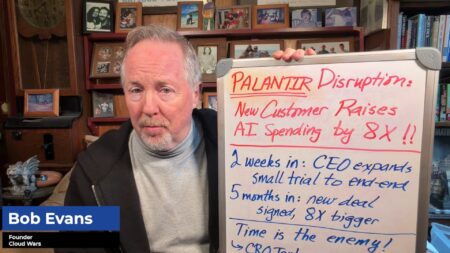
Welcome to this exclusive interview with Amit Zavery, president, chief product officer, and chief operating officer at ServiceNow. Zavery and Bob Evans, founder, Cloud Wars, sit down to discuss end-to-end connectivity, real-time data analytics, and a comprehensive approach to automation. They also talk about addressing customer needs through visibility and integration to create a seamless user experience across fragmented data silos.
Highlights
ServiceNow’s Unique Platform and Integration Capabilities (00:08)
A big part of the appeal of ServiceNow’s platform is its ability to integrate various technologies seamlessly without requiring heavy lifting from customers. It’s been described as a single, integrated data model that can adapt to new business requirements and technologies. Zavery discusses ServiceNow’s unique capabilities that allow it to connect every part of a business without the need for extensive coding or hardwiring.
ServiceNow’s Advantage in AI and Agent Technology (03:46)
While others focus on building agents for specific systems, ServiceNow has the experience to build agents that work across multiple systems. Zavery explains that ServiceNow’s agentic orchestrator can manage complex workflows, breaking tasks into smaller pieces and ensuring end-to-end fulfillment, which is a unique capability in the market.
He uses the example of employee onboarding as a time when end-to-end connectivity is desired. “I want to do employee onboarding . . . You know that it’s going to touch 20 different systems. There’s no way out.” ServiceNow can work with all the systems on the back end. He mentions the orchestrator’s ability to manage tasks and ensure outcomes, leveraging years of workflow experience to provide customers with predictable results.
ServiceNow’s Open and Multi-Cloud Strategy (08:17)
Zavery emphasizes ServiceNow’s commitment to being an open, heterogeneous, and multi-cloud platform, which he believes is essential for enterprise success. He notes that ServiceNow is the only software-as-a-service (SaaS) vendor present in all three major cloud providers: Google Cloud, Microsoft Azure, and AWS.
The platform is described as infrastructure-agnostic: “Now you can write on private cloud. We host it as well in our cloud, as well as all the three hyperscalers.” He shares the importance of supporting various large language models and the ability to integrate with other systems, such as Oracle and Google Cloud, to enhance customer value.
ServiceNow’s Data Analytics and Ecosystem Play (10:46)
Zavery discusses data analytics and ServiceNow’s integration with various data sources, such as Oracle and Google Cloud’s BigQuery. He mentions the launch of the integration hub and the automation engine, which allow for real-time data analytics and actionable insights.
ServiceNow can provide great depth of information, including details about cloud and on-premise assets, which can be valuable for technical support. He talks about the need for an aggressive ecosystem play, with ServiceNow integrating with various partners to provide comprehensive tools for customers.
Addressing Customer Needs: Automation, Visibility, and Integration (14:54)
Customers seek to automate processes and achieve efficiency while managing the growing complexity of their systems. They desire visibility into fragmented operations and the ability to adapt to new business requirements securely and cost-effectively. ServiceNow’s platform facilitates these goals by integrating technologies and leveraging AI, ultimately streamlining workflows and delivering predictable outcomes without overwhelming users with complexity. “When we talk about agentic [AI], I do believe it is the holy grail of automation. . . .this is what people have been looking for.”
Integrating Offerings for Fragmented Data Silos with Workflow Data Fabric (17:54)
To effectively address customer needs, it’s essential to identify the specific business problems they face, particularly in managing fragmented data silos. ServiceNow’s Workflow Data Fabric offers visibility without requiring the migration of all data, enabling better outcomes. It creates a closed-loop system that continually refines AI outcomes. This unified platform reduces the complexity of implementing multiple tools.
Enhancing User Experience with AI and Workflow Integration (19:44)
The focus should be on solving customer challenges by effectively understanding user intent rather than merely implementing AI as a surface-level enhancement. While many tools use large language models as wrappers, ServiceNow combines intent recognition with a robust reasoning engine to fulfill user requests. By integrating search, AI agents, and workflows, ServiceNow streamlines complex tasks across multiple systems into a simple interface, ensuring that users can achieve their goals efficiently.
Simplifying Task Fulfillment Through Integrated AI, Workflow, and Search (21:54)
ServiceNow aims to streamline the user experience by combining AI, workflow, and data with a simple search interface. Unlike other tools that only guide users, ServiceNow automates the entire process, completing tasks like maternity leave requests across various platforms. This “last mile” of service, often the most challenging aspect of business operations, is where ServiceNow excels.
Fulfillment in Business Automation (23:47)
Many offerings promise efficiency but fail to deliver complete fulfillment for customers. ServiceNow stands out as a company that not only proposes solutions but also ensures end-to-end execution across various systems, addressing the fragmentation and leaving customers feeling stranded.










